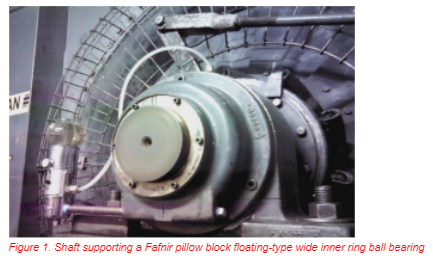Unintended Consequences of Bearing Maintenance
InfraMation 2018 Application Paper Submission
By Hank Herber and Paul Ruston Parker
Los Alamos National Laboratory
ABSTRACT
Los Alamos National Laboratory’s Steam Plant delivers heating and process steam to 3.2 million square feet of computing facilities, scientific laboratories, and administrative facilities on the central TA-3 campus. The plant runs on three (3) natural gas–fired boilers with backup diesel fuel–firing capabilities, each capable of producing over 100,000 pounds of steam per hour. Reliable steam generation is an essential function for the Laboratory’s mission.
In the month of November, when temperatures typically drop below freezing and steam demand starts to peak, infrared thermography revealed an anomaly on a critical piece of power plant equipment. An elevated shaft temperature indicated imminent failure, which could take the boiler offline.
This is the story of a bearing assembly on a Sturtevant Turbo-vane fan that went awry during replacement. The fan was originally commissioned in 1949. Life is so much easier when you just follow directions.
STURTEVANT TURBO-VANE FAN CASE HISTORY
The shaft in question supports a Fafnir pillow block floating-type wide inner ring ball bearing. The shaft size diameter is 4 7/8” (Figure 1).

At some point in the past the bearing was replaced (accurate records are not available).
During the process of putting all the parts together, three minor details were overlooked, which resulted in an elevated shaft temperature.
Over the years the presumption was that this pillow block bearing always ran hot (measured at 190°F), especially if compared to the inboard bearing, which usually recorded about 20°F above ambient temperature.
When infrared thermography was introduced for mechanical monitoring, the shaft was imaged, and the temperature was found to be 466°F (Figure 2).

Vibration analysis had not found any mechanical issues with this bearing; in fact, vibration levels throughout the motor and fan bearings historically remained in the excellent range (Figure 3).

Thermal energy flows from high temperature to low, but the source of the high temperature was never considered to originate at the shaft of this fan. Thermal energy generates from the movement of molecules and in this story, the movement of molecules originated from the packing rings rubbing on the shaft.
So, what was the cause of the elevated shaft temperature?
The manufacture assembly instructions recommend:
- Position bearing on shaft and in the housing. Be sure the cam end of the inner ring points out. The bearings are designed for a slip fit on the shaft. To position the floating bearing in its housing, measure the collar projection on the fixed unit and duplicate it on the floating unit. Since the collar projection are the same on both bearings, the floating bearing will atomically be positioned in the center of the floating space. Bolt the pillow blocks securely in position on a flat surface.
- Slide drive collar into position against bearing inner ring. Turn until cam in collar and on end of inner ring engage. With a drift or spanner wrench turn the collar in the direction of shaft rotation to engage it tightly and lock the inner ring to the shaft.
- Tighten the setscrew.
- Replace gasket and packing’s, also cover and plate. Apply gasket carefully so as not to tear or crimp it.
- Bolt on the end-cover. When replacing plates and packing rings, draw up the screws just enough to hold packing ring snugly in place, then fill with oil as directed in the section in the section on Lubrication. After assembly is complete, check carefully to see that the outside diameter of the shaft and the housing bore clear equally all around. Be sure packing rings are not too tight. This can best be checked after the unit is operating. If considerable heat develops, ease off on the screws holding the plate.
It is unclear if steps 4 and 5 were closely followed.
A post mortem investigation identified the use of over-sized packing. To reduce shaft temperatures prior to replacing the packing, the lubricant was changed from grease as the manufacture recommends to oil. This provided zero relief from the elevated shaft temperatures.
The next step to reduce shaft temperature was to install a brand-new bearing; however, a replacement bearing for that size shaft could not be found. Since vibration analysis confirmed that there were no signs of damage, the old bearing was disassembled, cleaned up, and thoroughly inspected. Minor flaws were discovered, but they were of no consequence and the same bearing was reinstalled, taking great care to follow the manufacturer’s assembly instructions. The lubricant used was grease, the correct size packing rings were installed, and the bearing underwent a test run with no unusual heat generated in either the bearing or the shaft.
Results can be seen in Figure
The difference in temperature from the incorrect to correct installation totaled a staggering 360°F.
SUMMARY
Infrared thermography should be part of every predictive maintenance toolbox. In this incident, vibration analysis could not find any fault with this bearing, but infrared thermography did find a problem with the installation.
All the extra effort and man-hours invested in trying to isolate the cause of overheating could have been avoided if the manufacturer’s assembly instructions had been followed accurately when the bearing was replaced.
ACKNOWLEDGMENTS
Nathan Hilliard Hughes – Mechanical Engineer, Los Alamos National Laboratory, for his contribution in supplying IR images.
Shawn Louis Hailey – Professional Engineer – Group Leader, Los Alamos National Laboratory, for his technical input, patience, and generous allowance of my time.
REFERENCES
Fafnir - Mounting and Lubrication and Maintenance of Fafnir Fixed and Floating Type Wide Inner Ring Ball Bearing Pillow Blocks
Infrared Training Center – Level I Thermography – Course Manual.
ABOUT THE AUTHORS
Hank Herber – Hank has been performing predictive services for over 30 years. Certified Level II Infrared Thermographer, Certified Level II Airborne Ultrasound and Certified Level II Vibration Analysis.
Paul Parker, PE - 20 years Systems Engineer at Los Alamos National Laboratory Co-Generation Plant. Previously Branch Manager of Electric and Steam Utilities.